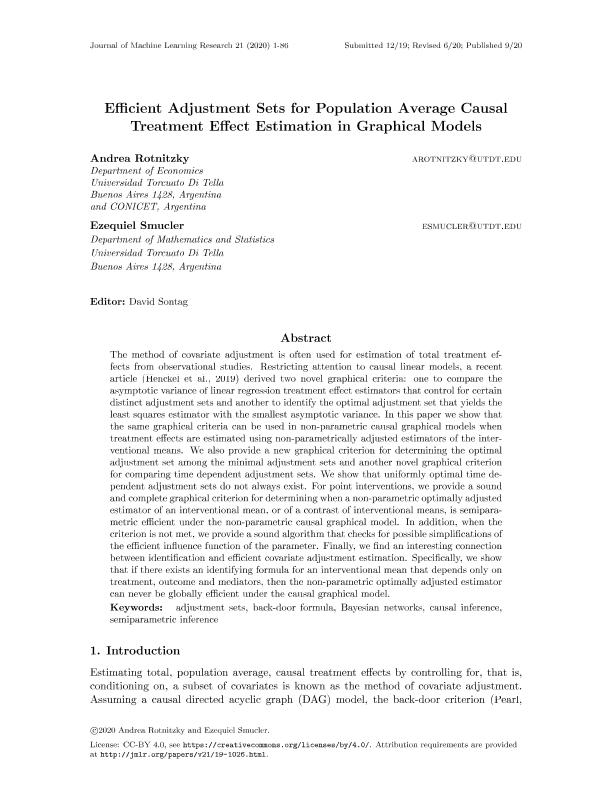Mostrar el registro sencillo del ítem
dc.contributor.author
Rotnitzky, Andrea Gloria

dc.contributor.author
Smucler, Ezequiel

dc.date.available
2022-09-12T13:27:54Z
dc.date.issued
2020-02
dc.identifier.citation
Rotnitzky, Andrea Gloria; Smucler, Ezequiel; Efficient Adjustment Sets for Population Average Causal Treatment Effect Estimation in Graphical Models; Microtome; Journal of Machine Learning Research; 21; 188; 2-2020; 1-86
dc.identifier.issn
1532-4435
dc.identifier.uri
http://hdl.handle.net/11336/168307
dc.description.abstract
The method of covariate adjustment is often used for estimation of total treatment effects from observational studies. Restricting attention to causal linear models, a recent article (Henckel et al., 2019) derived two novel graphical criteria: one to compare the asymptotic variance of linear regression treatment effect estimators that control for certain distinct adjustment sets and another to identify the optimal adjustment set that yields the least squares estimator with the smallest asymptotic variance. In this paper we show that the same graphical criteria can be used in non-parametric causal graphical models when treatment effects are estimated using non-parametrically adjusted estimators of the interventional means. We also provide a new graphical criterion for determining the optimal adjustment set among the minimal adjustment sets and another novel graphical criterion for comparing time dependent adjustment sets. We show that uniformly optimal time dependent adjustment sets do not always exist. For point interventions, we provide a sound and complete graphical criterion for determining when a non-parametric optimally adjusted estimator of an interventional mean, or of a contrast of interventional means, is semiparametric efficient under the non-parametric causal graphical model. In addition, when the criterion is not met, we provide a sound algorithm that checks for possible simplifications of the efficient influence function of the parameter. Finally, we find an interesting connection between identification and efficient covariate adjustment estimation. Specifically, we show that if there exists an identifying formula for an interventional mean that depends only on treatment, outcome and mediators, then the non-parametric optimally adjusted estimator can never be globally efficient under the causal graphical model.
dc.format
application/pdf
dc.language.iso
eng
dc.publisher
Microtome

dc.rights
info:eu-repo/semantics/openAccess
dc.rights.uri
https://creativecommons.org/licenses/by/2.5/ar/
dc.subject
Graphical Models
dc.subject
Adjustment sets
dc.subject
Influence functions
dc.subject
Bayesian networks
dc.subject.classification
Estadística y Probabilidad

dc.subject.classification
Matemáticas

dc.subject.classification
CIENCIAS NATURALES Y EXACTAS

dc.title
Efficient Adjustment Sets for Population Average Causal Treatment Effect Estimation in Graphical Models
dc.type
info:eu-repo/semantics/article
dc.type
info:ar-repo/semantics/artículo
dc.type
info:eu-repo/semantics/publishedVersion
dc.date.updated
2022-09-09T17:59:07Z
dc.identifier.eissn
1533-7928
dc.journal.volume
21
dc.journal.number
188
dc.journal.pagination
1-86
dc.journal.pais
Estados Unidos

dc.journal.ciudad
Massachusetts
dc.description.fil
Fil: Rotnitzky, Andrea Gloria. Consejo Nacional de Investigaciones Científicas y Técnicas; Argentina. Universidad Torcuato Di Tella. Departamento de Economía; Argentina
dc.description.fil
Fil: Smucler, Ezequiel. Consejo Nacional de Investigaciones Científicas y Técnicas; Argentina. Universidad Torcuato Di Tella. Departamento de Economía; Argentina
dc.journal.title
Journal of Machine Learning Research

dc.relation.alternativeid
info:eu-repo/semantics/altIdentifier/url/https://www.jmlr.org/papers/v21/19-1026.html
Archivos asociados
